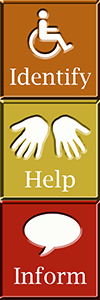Access Needs and Disability Assistance
FAU recognizes that individuals may require assistance with alerting, evacuating, and sheltering in the event of an emergency. The University encourages all individuals (students, faculty, staff and visitors) who may need assistance in an emergency to identify themselves to the University. Once an individual has self-identified, the University will collaborate with the individual to address emergency planning needs. FAU also asks that all members of the University community provide, within the limits of their abilities, assistance to those individuals requiring it, during or after an emergency.

Identify:
- Individuals requiring assistance: Self-identify before an emergency event.
- University community: Identify those who require assistance to get to a safe place during an emergency event.
Help:
- Individuals requiring assistance: Seek assistance to get to a safe place.
- University community: Provide assistance to get those who require it, to get to a safe place.
Inform:
- Individuals requiring assistance: Inform those providing assistance of how to best assist you.
- University community: Inform emergency personnel of the location of those requiring assistance that goes beyond your abilities or means.
See University Resources for more information, including the self-identification process.
FAQ
It is recommended individuals requiring assistance prepare for emergencies by:
- Familiarizing yourself with the layout of the buildings you routinely visit.
- Planning a shelter-in-place strategy or escape route.
- Telling a co-worker or instructor how to assist you in case of emergency.
- Leave the area, if possible, or make your way to a safe place, depending on the nature of the emergency, such as an interior room, stairway, entrance or designated area of refuge and ask for assistance from others.
- Establish a “Buddy” system to help you to a safe place.
- Know the needs and capabilities of the people requiring assistance who are routinely in your work area.
- Ask how you can help anyone requiring assistance before giving it.
- GUIDE the individual quickly to reasonable safety, to a stairway entrance, designated area of refuge, an enclosed room or space, out of way from the stream of traffic.
- Accompany any action by a verbal explanation so that the person being assisted understands what is happening and why these actions are being take
- CALL 911 immediately if a telephone is available, and provide the following:
- The individual’s name and location within the building .
- The phone number from which the call is being made.
If left alone, the individual may wish to remain on the phone with emergency personnel.
- If available, a companion, or other responsible person may remain with and assist the individual.
- Inform emergency personnel of the exact location of the individual(s) with the disability(ies).
Trained, equipped, emergency personnel will facilitate the evacuation of individuals with disabilities.
General guidelines in providing assistance
- Offer assistance verbally and guide them to the nearest exit or safe place away from the emergency.
- Do not grab their hands and pull them along. Instead, offer your elbow to them. It is easier to hold on to a sighted person’s elbow while moving. If possible, someone should follow behind to protect the individual from being pushed down in the event of crowding.
Get their attention and convey information by:
- Using hand gestures or writing calmly advise them of what is happening and where to go..
- Guide individuals to a safe place, away from the emergency event, as they may not be able to follow oral commands
These include individuals wearing casts and/or using canes or crutches, or those who are wheelchair bound, and those sustaining injuries during the emergency that render them immobile
- Provide assistance based solely upon their ability to maneuver through doorways and up/down stairs to reduce the risk of injury.
They should not be moved by untrained personnel unless the situation is life-threatening (Fire Rescue/Police personnel are trained personnel).
- If individuals can walk with assistance, a “buddy” should assist and accompany the individual when moving to a safe area.
- If located on an upper floor, individuals may be assisted to a stairway entrance or designated area of refuge to await evacuation or further instructions from emergency personnel. If the individual is capable of walking with assistance, a “buddy” should assist and accompany the individual when descending the stairs.
For all EMERGENCY CALLS dial 9-1-1
Contact Us
Campus Operations Building
(69) Boca Raton Campus
Email: em@fau.edu